India’s culinary heritage is a rich tapestry of flavors, ingredients, and traditions, reflecting the country’s diverse cultural identity. Among the myriad sweets that form the backbone of Indian gastronomy, rasgulla occupies a special place. Known for its spongy texture, syrupy sweetness, and melt-in-the-mouth quality, rosogulla is more than just a dessert—it’s a symbol of joy, tradition, and celebration.
In this article, we delve deep into the history, cultural importance, preparation, and evolution of rasgulla, offering a holistic understanding of why this sweet treat holds such an esteemed place in Indian hearts.
- History of Rasgulla
- Cultural Significance of Rasgulla
- The Science and Art of Making Rasgulla
- Traditional preparation method in West Bengal
- Traditional preparation method in odisha
- Variations of Rasgulla
- Rasgulla on the Global Stage
- The Rasgulla Debate : Odisha vs. Bengal
- Health and Nutrition Benefits of Rasgulla
- Conclusion
History of Rasgulla
Origins in Odisha
The origins of rasgulla are deeply intertwined with the traditions of Odisha, particularly with the offerings made to Lord Jagannath at the famous Jagannath Temple in Puri. Historical records suggest that a version of rasgulla, called Khira Mohana, was offered as a part of the temple rituals, dating back to the 13th century. This temple delicacy became an integral part of the bhog during the annual Rath Yatra festival, symbolizing divine blessings.
In Odisha, the Pahala Rasgulla—named after the village of Pahala near Bhubaneswar—remains a cherished version of the sweet. This version is slightly caramelized, with a distinct flavor and texture that sets it apart from its counterparts.
Rasgulla Historical background in West odisha
The historical roots of rasgulla in Odisha trace back to the sacred kitchens of the Jagannath Temple in Puri, where a similar sweet, known as khira mohana, has been part of rituals since the 12th century. This dessert, made from chhena (curdled milk) and sweetened syrup, was traditionally offered to Lord Jagannath and holds special significance during the Niladri Bije festival, symbolizing reconciliation between Lord Jagannath and Goddess Lakshmi. The Pahala Rasgulla, named after the village of Pahala near Bhubaneswar, is considered a rustic descendant of this temple tradition. Odisha’s claim to rasgulla’s origins is supported by its deep integration into religious practices, cultural identity, and its recognition with a Geographical Indication (GI) tag in 2017, emphasizing the dessert’s ancient and spiritual connection to the region.
Bengal’s Contribution
The modern, spongier Rosogolla that most people recognize today is credited to Nobin Chandra Das, a confectioner from Kolkata in the 19th century. Nobin Chandra refined the recipe to create a lighter, softer version of the sweet, which quickly gained immense popularity in Bengal. This adaptation gave birth to the Banglar Rasogolla, celebrated for its pristine white color, delicate texture, and mild sweetness.
The rivalry between Odisha and Bengal over the origin of rosogulla culminated in a friendly competition for the Geographical Indication (GI) tag. In 2017, Odisha received the GI tag for its Pahala Rasgulla, while Bengal was awarded the GI tag for Banglar Rasogolla in 2018.
Rasgulla Historical background in West Bengal
The historical background of rasgulla in West Bengal is intricately tied to the innovation of Nobin Chandra Das, a 19th-century confectioner from Kolkata. Often referred to as the “Columbus of Rosogolla,” Das is credited with creating the modern version of this iconic sweet around 1868. He refined the use of chhena (curdled milk) to craft soft, spongy balls that retained their shape and absorbed sugar syrup perfectly, a technique previously unheard of in Bengali confectionery. This invention quickly gained popularity, becoming a staple in Bengali households and celebrations. Later, his son, Krishna Chandra Das, introduced canned rasgullas, ensuring their widespread distribution across India and beyond, cementing the sweet’s place as a symbol of Bengal’s culinary heritage.

Cultural Significance of Rasgulla
Rasgulla is not merely a dessert; it is deeply ingrained in Indian culture and traditions. Its presence extends beyond the dining table into religious ceremonies, social celebrations, and even cultural diplomacy.
Religious Offerings
In Odisha, rasgulla holds immense spiritual significance. During the Niladri Bije ceremony of the Jagannath Temple, It is offered to appease Goddess Lakshmi as part of the rituals. This tradition underscores the sweet’s association with devotion and divine blessings.
Symbol of Celebration
Rasgulla has become synonymous with festivities in India. Be it weddings, festivals like Durga Puja, or simple family gatherings, rasgulla serves as a sweet expression of happiness and goodwill. It is often exchanged as a token of love and respect.
A Sweet for Diplomacy
Rasgulla has transcended its cultural roots to become an ambassador of Indian cuisine on the global stage. It has been presented as a culinary gift during diplomatic events, symbolizing India’s rich heritage.
The Science and Art of Making Rasgulla
Despite its simple list of ingredients—milk, sugar, and water—making rasgulla requires precision and skill. Its unique texture and flavor come from a delicate balance of technique and timing.
Ingredient of Rasgulla
- Chhena (Curdled Milk): Freshly curdled milk is the base of rasgulla. The quality of the milk significantly influences the final texture.
- Sugar Syrup: A light sugar syrup provides the sweetness and serves as the cooking medium.
- Flavoring Agents: Optional ingredients like rose water, cardamom, or saffron are sometimes added for a nuanced aroma.
The Preparation Process
- Curdling the Milk: Milk is brought to a boil and curdled using lemon juice, vinegar, or curd. The whey is drained, leaving behind the soft chhena.
- Kneading: The chhena is kneaded until it becomes smooth and pliable. This step is critical for achieving the signature spongy texture.
- Shaping: Small balls are shaped from the dough, ensuring there are no cracks.
- Cooking: The balls are gently boiled in sugar syrup for 15-20 minutes. The heat and movement allow the rasgullas to absorb the syrup while expanding in size.
Traditional preparation method in West Bengal
The traditional preparation of rasgulla in West Bengal involves a careful and precise method. First, full-fat milk is boiled, and an acidic agent such as lemon juice or vinegar is added to curdle the milk, separating the chhena (curdled milk) from the whey. The chhena is then drained, washed with cold water to remove the acidic taste, and kneaded thoroughly into a smooth dough. Small, smooth balls are shaped from the dough, ensuring there are no cracks. These balls are then cooked in a light sugar syrup, where they are boiled until they expand and become spongy, absorbing the syrup. This delicate process results in the soft, sweet, and syrup-soaked rasgulla, a beloved treat that has become synonymous with Bengali cuisine.
Traditional preparation method in odisha
In Odisha, the traditional preparation of rasgulla follows a process deeply rooted in the state’s culinary heritage. The key ingredient, chhena (curdled milk), is first made by boiling full-fat milk and adding an acidic agent, such as lemon juice or vinegar, to curdle the milk and separate the whey. The chhena is then drained, washed to remove any residual acidity, and kneaded to a smooth, soft dough. Unlike the Bengali version, Odisha’s Pahala Rasgulla is typically denser and has a slightly caramelized texture. The dough is shaped into small, smooth balls, which are gently boiled in a light sugar syrup. As they cook, the rasgullas absorb the syrup, becoming soft, spongy, and rich in flavor. This traditional method, especially popular in the Pahala region, has been passed down through generations and remains a cherished part of Odisha’s cultural identity.
Variations of Rasgulla
White Rasgulla
White Rasgulla is a popular Bengali sweet made from soft, spongy chhena (Indian cottage cheese) soaked in a light, sugary syrup. Known for its delicate, melt-in-the-mouth texture, it is often considered a symbol of Bengali culinary tradition. The sweet is typically white, unlike its darker counterpart, the brown Rasgulla, as it is made using a more refined process that preserves its light color. Its sweetness is subtle, and the syrup adds just the right amount of moisture without overpowering the flavor of the chhena. Traditionally served during festive occasions or celebrations, White Rasgulla has gained popularity across India and beyond for its simple yet irresistible taste.
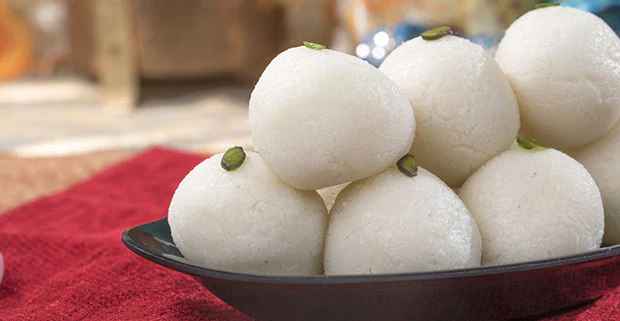
Kesar Rasgulla
Kesar Rasgulla is a delightful Indian sweet that combines the soft, spongy texture of traditional Rasgulla with the aromatic richness of saffron (kesar). The white, pillowy balls are made from chhena (Indian cottage cheese) and soaked in a fragrant sugar syrup. Infused with the warm, golden threads of saffron, Kesar Rasgulla offers a luxurious twist to the classic recipe. Its delicate sweetness is balanced by the earthy, floral notes of saffron, making it an indulgent treat perfect for special occasions. With its vibrant color and exquisite flavor, Kesar Rasgulla is a beloved dessert that adds a touch of elegance to any celebration.
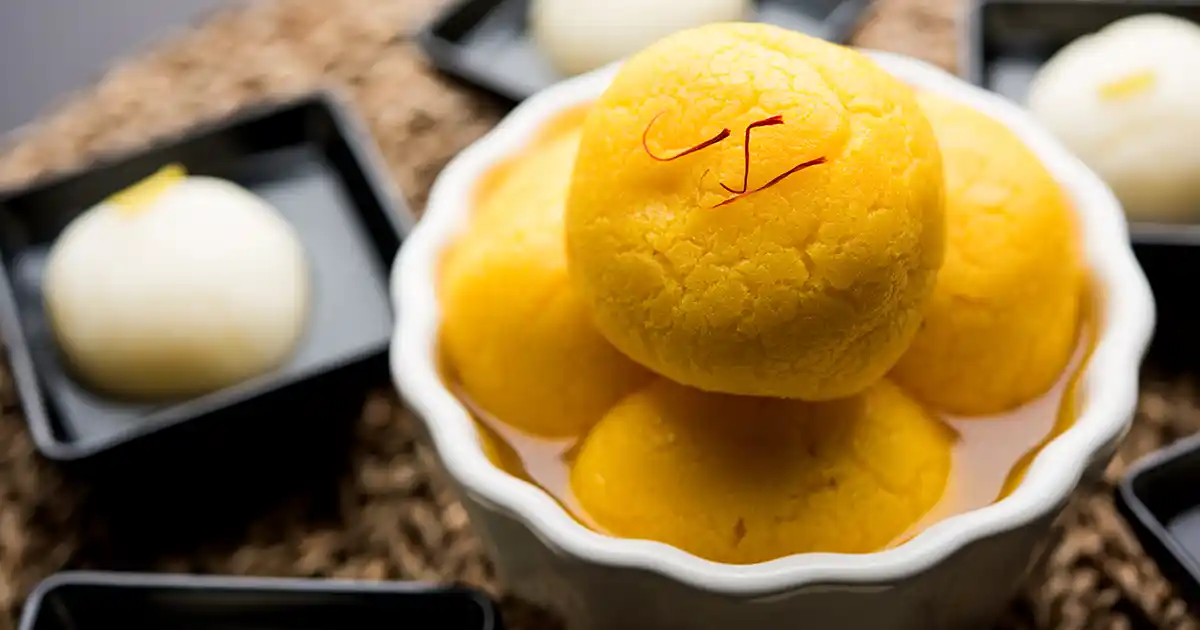
Mango Rasgulla
Mango Rasgulla is a delightful twist on the traditional Bengali sweet, combining the soft, spongy texture of rasgulla with the rich, tropical flavor of mango. This fusion dessert is made by infusing the classic rasgulla with mango puree, giving it a vibrant color and a refreshing taste. The rasgullas are soaked in a sugar syrup, which is often flavored with a hint of cardamom, enhancing the overall sweetness. Perfect for summer or festive occasions, Mango Rasgulla offers a delightful balance of sweetness and fruity richness, making it a beloved treat for those who enjoy innovative variations of classic desserts.
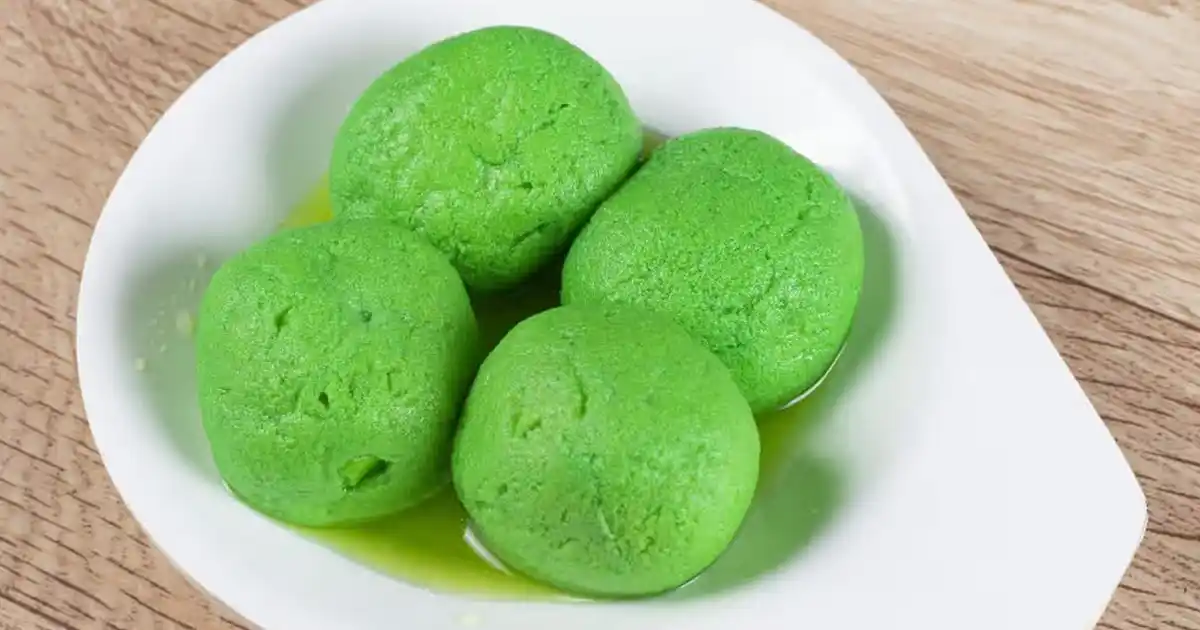
Chocolate Rasgulla
Chocolate Rasgulla is a delightful fusion dessert that combines the soft, spongy texture of traditional rasgullas with the rich, indulgent flavor of chocolate. Originating from the iconic Bengali sweet, rasgulla, this innovative version adds a layer of cocoa, creating a perfect balance between sweetness and the bittersweet notes of chocolate. The rasgullas are typically soaked in a sugar syrup, but in this variation, they are infused with chocolate syrup or a cocoa-rich sauce, making every bite a decadent treat. Whether served chilled or at room temperature, Chocolate Rasgulla offers a unique and delicious twist to a classic favorite.
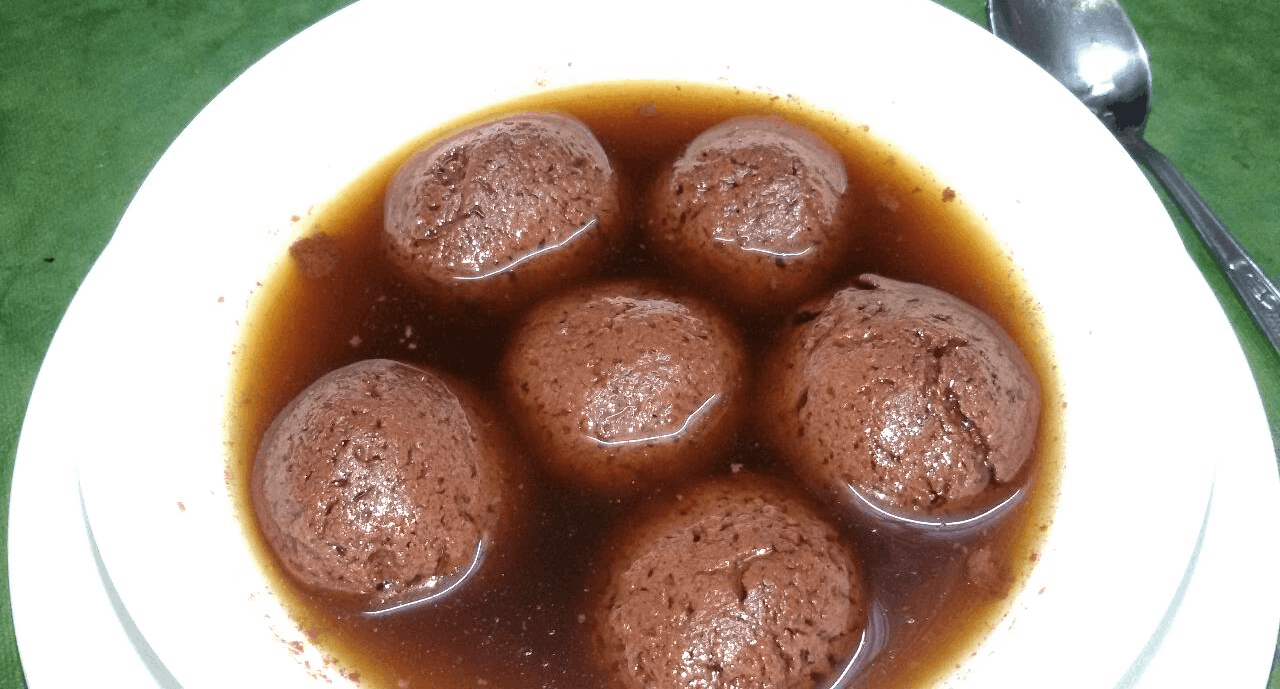
Baked Rasgulla
Baked Rasgulla is a delightful twist on the traditional Bengali sweet, offering a unique and indulgent experience. Made from soft, spongy cheese balls, this dish elevates the classic Rasgulla by baking it to a golden perfection, creating a subtle crunch on the outside while maintaining its delicate, syrup-soaked interior. Unlike the typical deep-fried or syrup-drenched versions, baking brings out a slightly caramelized flavor, enhancing the sweetness and richness. With a touch of cardamom and saffron, Baked Rasgulla adds a contemporary flair to a beloved dessert, making it an ideal fusion treat for festive occasions and special gatherings.
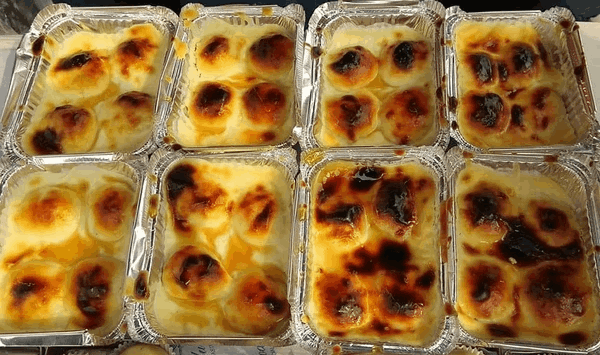
Rasgulla on the Global Stage
The global popularity of Indian cuisine has brought rasgulla to the attention of international food enthusiasts. It is now a staple dessert at Indian restaurants worldwide. Additionally, Indian chefs have incorporated rasgulla into creative fusion dishes, showcasing its versatility.
At international food festivals and culinary competitions, It is often featured as a signature Indian sweet. Its light texture and unique preparation method intrigue food lovers and chefs alike.
The Rasgulla Debate : Odisha vs. Bengal
The friendly rivalry between Odisha and Bengal over the origin of rasgulla reflects the sweet’s cultural importance. While both states have their distinct versions, the debate has brought much-deserved attention to India’s rich culinary history.
Odisha’s Claim
Odisha argues that rasgulla originated as Khira Mohana in the Jagannath Temple, making it an ancient dish with religious significance.
Bengal’s Contribution
Bengal transformed rosogolla into a commercially viable dessert, popularizing it across India and the world.
Both states have their unique contributions, and this rivalry only highlights the diversity of Indian cuisine.

Health and Nutrition Benefits of Rasgulla
Rasgulla, while a delicious indulgence, also offers some health and nutritional benefits when consumed in moderation. Made primarily from chhena (curdled milk), it is a good source of protein and calcium, which are essential for muscle growth, bone health, and overall body function. The milk used in rasgulla also provides vitamins like A and D, supporting immune function and skin health. Additionally, since rasgulla is typically prepared by boiling rather than frying, it tends to be lower in fat compared to other fried sweets. However, due to its sugar content, it’s important to enjoy rosogulla in moderation, especially for those managing blood sugar levels. Variants like sugar-free rasgulla are also available, offering a healthier option for those with dietary restrictions. Overall, This sweet can be part of a balanced diet when consumed occasionally.
Conclusion
Rasgulla is not just a dessert; it is an embodiment of Indian culture, tradition, and innovation. From its ancient roots in Odisha to its modern adaptations in Bengal and beyond, This sweet has become a timeless symbol of sweetness and joy. Its universal appeal lies in its simplicity, versatility, and ability to adapt to changing tastes.
As India continues to celebrate its culinary heritage, It remains a shining example of how food can transcend boundaries, evoke emotions, and connect people. Whether served at a festive gathering, offered as a token of love, or enjoyed as a personal treat, rosogulla truly encapsulates the essence of Indian hospitality and tradition.

Wonderful post! I’ve shared this with a few friends.
Thank You For Your Response Shopify
Thanks for this detailed post! Do you think this strategy
works equally well for various markets?
Thank You For Your Response Medium